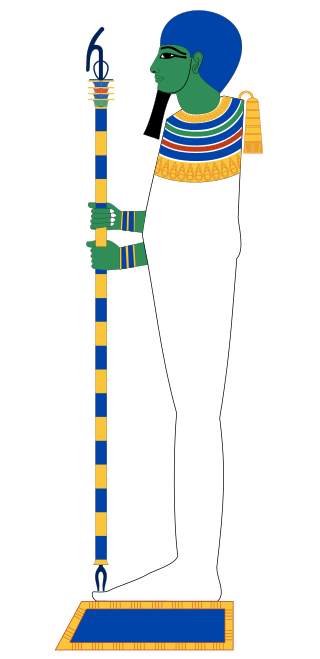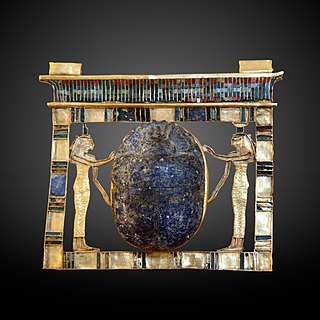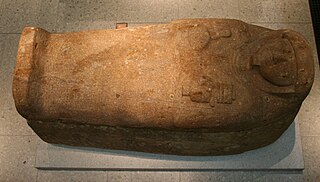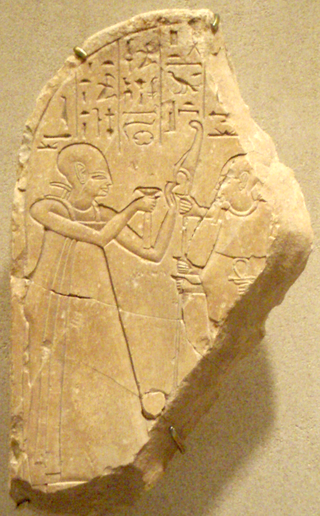
Memphis, or Men-nefer, was the ancient capital of Inebu-hedj, the first nome of Lower Egypt that was known as mḥw ("North"). Its ruins are located in the vicinity of the present-day village of Mit Rahina, in markaz (county) Badrashin, Giza, Egypt. This modern name is probably derived from the late Ancient Egyptian name for Memphis mjt-rhnt meaning "Road of the Ram-Headed Sphinxes".

Ptah is an ancient Egyptian deity, a creator god and patron deity of craftsmen and architects. In the triad of Memphis, he is the husband of Sekhmet and the father of Nefertem. He was also regarded as the father of the sage Imhotep.

Hedjkheperre Setepenre Takelot II Si-Ese was a pharaoh of the Twenty-third Dynasty of Ancient Egypt in Middle and Upper Egypt. He has been identified as the High Priest of Amun Takelot F, son of the High Priest of Amun Nimlot C at Thebes, and thus, the son of Nimlot C and grandson of king Osorkon II, according to the latest academic research. Based on two lunar dates belonging to Takelot II, this Upper Egyptian pharaoh is today believed to have ascended to the throne of a divided Egypt in either 845 BC or 834 BC. Most Egyptologists today, including Aidan Dodson, Gerard Broekman, Jürgen von Beckerath, M.A. Leahy, and Karl Jansen-Winkeln, also accept David Aston's 1989 hypothesis that Shoshenq III was Osorkon II's actual successor at Tanis, rather than Takelot II. As Aidan Dodson and Dyan Hilton write in their comprehensive book on the royal families of Ancient Egypt:
Takelot II is likely to have been identical with the High Priest Takelot F, who is stated in [the] Karnak inscriptions to have been a son of Nimlot C, and whose likely period of office falls neatly just before Takelot II's appearance.

Usermaatre Setepenamun Osorkon II was the fifth king of the Twenty-second Dynasty of Ancient Egypt and the son of King Takelot I and Queen Kapes. He ruled Egypt from approximately 872 BC to 837 BC from Tanis, the capital of that dynasty.
Prince Khaemweset was the fourth son of Ramesses II and the second son by his queen Isetnofret. His contributions to Egyptian society were remembered for centuries after his death. Khaemweset has been described as "the first Egyptologist" due to his efforts in identifying and restoring historic buildings, tombs and temples.

Isetnofret was one of the Great Royal Wives of Pharaoh Ramesses II and was the mother of his successor, Merneptah. She was one of the most prominent of the royal wives, along with Nefertari, and was the chief queen after Nefertari's death.

Thutmose was the eldest son of Pharaoh Amenhotep III and Queen Tiye, who lived during the Eighteenth Dynasty of Egypt. His early death led to the reign of Akhenaten, his younger brother—as the successor to the Egyptian throne—and the intrigues of the century leading up to Ramesses II, the start and ultimately the failure of Atenism, the Amarna letters, and the changing roles of the kingdom's powers.

Paser was an ancient Egyptian noble who served as vizier during the reigns of Seti I and Ramesses II in the 19th Dynasty. He would later also become High Priest of Amun.

The High Priest of Ptah was sometimes referred to as "the Greatest of the Directors of Craftsmanship". This title refers to Ptah as the patron god of the craftsmen.

Khuwyptah was a High Priest of Ptah in Memphis from the reign of Neferirkare Kakai in the 5th Dynasty.

Pahemnetjer(p3-ḥm-nṯr; "servant of the god", "priest") was a High Priest of Ptah during the reign of Ramesses II. Pahemnetjer succeeded Huy as High Priest of Ptah and was in turn succeeded by his son Didia.

Shoshenq was a High Priest of Ptah during the 22nd Dynasty. Shoshenq was the eldest son of Osorkon II and Queen Karomama. He presided over the burial of the twenty-seventh Apis bull in Saqqara. For unknown reasons Shoshenq did not succeed to his father's throne and was buried in Memphis when Shoshenq III was king of Egypt. Shoshenq's tomb was found unplundered in 1942.

Hori was the High Priest of Ptah at the very end of the reign of Ramesses II. Hori succeeded Neferronpet in office.

Neferronpet was Vizier and the High Priest of Ptah from the reign of Ramesses II to the reign of Seti II.

Ptahmose was High Priest of Ptah in Memphis during the time of Thutmose IV and/or Amenhotep III. He was the son of a Prophet (priest) named Menkheper. Ptahmose's son Pahonte would later serve as High Priest of Ptah.

Senbuy was High Priest of Ptah in Memphis during the late Middle Kingdom of Egypt . Senbuy is known from a stela now in the Fitzwilliam Museum in England. Senbuy is depicted with his wife, the king's ornament Nubemheb, and their son Re-Seth. Senbuy's titles on the stela are given as hereditary prince and count, one whose coming to the temple is awaited on the day of the rising of Sothis, the greatest of the directors of craftsmen of the Lord of All, chief priest of his god, the lector-priest.

The ancient Egyptian noble Prehotep II was Vizier in the latter part of the reign of Ramesses II, during the 19th Dynasty.

Pasherienptah (III)(p3-šrỉ-n-ptḥ, 'Son of Ptah'; November 4, 90 BCE – July 13 or 14, 41 BCE) was an ancient Egyptian high Priest of Ptah in Memphis from 76 BCE until his death. Two of his stelas are known, the one with a hieroglyphic inscription is in the Ashmolean Museum (Ash. M. 1971/18), the other, Demotic stela, of which only seven fragments have been found, is in the British Museum (BM 886).
Taimhotep was an ancient Egyptian woman known from two stelae made during the reign of Cleopatra VII. One of these, a limestone stela from 43 or 42 BCE was found in Memphis or Sakkara and is today in the British Museum, the other is a Demotic version of its text; its fragments are also in the British Museum.

The Genealogy of Ankhefensekhmet or Genealogy of the Memphite priestly elite is an ancient Egyptian relief – sometimes referred to as a stela – normally identified as having been made during the 8th century BCE, under the reign of pharaoh Shoshenq V of the late 22nd Dynasty. A surviving block is kept at the Egyptian Museum of Berlin. The relief was issued by a priest called Ankhefensekhmet with the purpose of illustrating his own genealogy. The relief traces back Ankhefensekhmet's sequence of ancestors up to 64 generations before, with the earliest individual, Ptahemheb, identified by Ritner as being from the time of Nebhepetre of the 11th Dynasty and alternatively identified by Borchart as being from the time of Nebkaure Khety of the 10th Dynasty. On 25 occasions the genealogy also names the pharaoh or king who was ruling at the time.


















